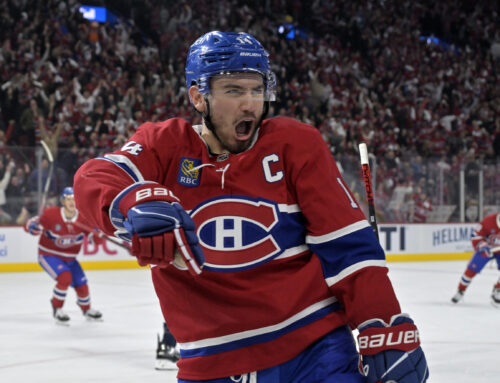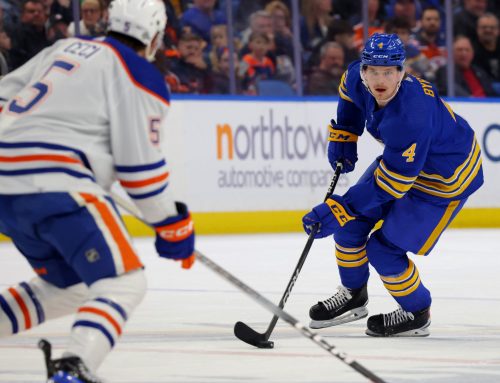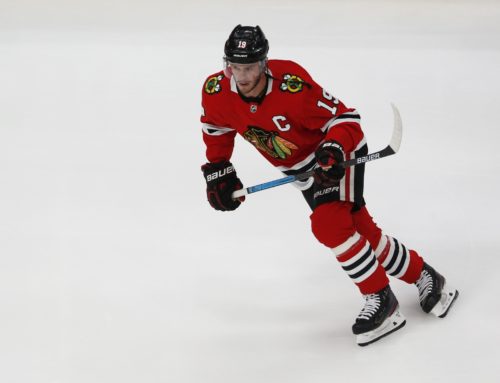
Winnipeg coach Paul Maurice told reporters on Sunday that Dustin Byfuglien hasn’t resumed skating so to not expect him back this week. The Jets play their final road game of their broken-up trip on Tuesday night before returning home for three contests. We’ll know more this weekend.
*
Taylor Hall was not skating in the game-day skate with the Devils on Monday morning.
*
Don't forget to grab your copy of the 2019 Dobber Midseason Fantasy Hockey Guide!
*
Mats Zuccarello was not on the ice for the Rangers on Monday. They have him listed as day-to-day with a foot infection but isn’t expected to play Tuesday. He should be available later this week.
While I’m on the topic, the likely trade of Zuccarello is an interesting case of expectations. At present time, he has 24 points in 35 games but is playing on a very good top line and top PP unit for the Rangers, often cracking 20 minutes a night. Let’s say he gets traded to somewhere like Calgary or San Jose, where does he slot? Does he get 18 minutes a game? 17? 15? What about his power play ice time? It could be a case where, fantasy-wise, having him stay put might be the best thing for his fantasy owners. Be careful what you wish for.
*
Shayne Gostisbehere was a late scratch Monday night, taking warm-ups and then leaving. He has a lower-body injury but it's not expected to be severe. He could be back in a few days.
*
As mentioned before the break, the Sens are expecting Colin White back in the lineup this weekend.
*
On the topic of the trade deadline, it appears that the Flyers are prepared to trade just about anyone. There are a lot of very good pieces on this team so hopefully Fletcher doesn’t just blow it up.
*
The Lightning expect Tyler Johnson to suit up for the team on Wednesday, having missed the team’s game just before the All-Star break.
*
Seth Jones was not at Columbus practice on Monday but is expected to play Tuesday night. Just in case he’s not, Zach Werenski was on the top PP unit with Ryan Murray on the second unit.
*
We got a pretty significant trade during the games last night as defenceman Jake Muzzin was acquired by the Toronto Maple Leafs in exchange for prospects Carl Grundstrom and (unsigned) Sean Durzi, as well as Toronto’s first-round pick this season. It appears he’ll slot right alongside Morgan Rielly immediately.
You can read Dobber’s take on the trade here.
*
It was a beatdown in Pittsburgh as New Jersey came flying out of the break for a 6-3 win. The game wasn’t as close as even that score would indicate. Travis Zajac had a monster game with one goal and three assists. Blake Coleman chipped in a goal and an assist as well.
Zajac’s huge performance aside, Coleman is having a great season in leagues counting hits. He’s now up to 18 goals, 29 points, nearly three shots per game, and over 130 hits after posting seven in the victory over the Penguins. I wrote about him last offseason and why he was a gamble worth taking this year. All that was true then is still true now, just with a bigger sample to work with.
*
James van Riemsdyk continued his hot streak Monday night, scoring the insurance marker in Philadelphia’s 3-1 win over Winnipeg. That makes eight goals and 10 points in his last 10 games. Be careful though: he’s not shooting a lot just yet. He’s only had 20 shots on goal in those 10 games, shooting 40 percent in the meantime. This is a guy who’s averaged three shots on goal in multiple seasons, including just last year. It’s a tricky situation for fantasy owners.
Carter Hart made 31 saves in the win.
*
Let’s take a few minutes to review Jordan Kyrou.
Sunday night, Kyrou participated in the AHL All-Star skills competition, posting the third-fastest lap in the history of the fastest skater competition. I wasn’t watching, but I saw the tweets and that led me to this thought:
quick fantasy hockey tweet: Jordan Kyrou is the guy you should be fishing for in dynasty leagues as the trade deadline approaches.
— Michael Clifford (@SlimCliffy) January 28, 2019
As of right now, Kyrou is a point-per-game player in his rookie AHL season with 28 points as a 20-year old. What’s even more special about that is how bad the San Antonio Rampage are: he leads the team in points despite playing 15+ fewer games than much of the roster, and the team being the sixth-lowest scoring team in the league. He has high-end speed, which isn’t enough in itself, but he’s a high-speed playmaker as well, and that separates him from a lot of players in my mind. He’s needed every bit of that speed and playmaking to have as much success as he has on a team so devoid of top-end talent.
The question for me is where Kyrou fits once he sticks with the big club. They have Vladimir Tarasenko, Jaden Schwartz, and David Perron all locked up for at least two more seasons after this one. Perron is capable of playing the left side if they so choose. If they decide to leave Perron on the right, Kyrou might be stuck on the third line for the time being.
All the same, this is about the lowest you’ll be able to pay for Kyrou for the foreseeable future, I think. He’s in the AHL and has already had an unsuccessful stint in the NHL. Maybe the Kyrou owner in your deep keeper or dynasty league is frustrated, or maybe he/she is looking for help this year to push for a title. It’s time to go fishing.
*
While on the topic of St. Louis wingers, don’t give up on Robby Fabbri yet, either. It has been a brutal 2018-19 season for him with just five points in 23 games, often finding himself either in the bottom-6 or a healthy scratch. Let’s be honest, though, it’s been a bad year for almost anyone in a Blues uniform to this point. If you didn’t draft Ryan O’Reilly or David Perron, you’re probably disappointed with your Blues selections.
But let’s not forget that over his first 123 regular season games from 2015-17, Fabbri had the same primary points per 60 minutes at five-on-five (1.37) as Mark Stone, and higher than names like Zach Parise, Patric Hornqvist, Tomas Hertl, and Jordan Eberle. It’s his first season after missing a year and a half with knee injuries and he just turned 23 years old last week.
This is basically a lost season for Fabbri but it’s also an important one. He’s back on the ice and has avoided catastrophic injury. That’s a win. Like Kyrou, his value will probably never be cheaper again in deep keeper/dynasty leagues than it is right now. It’s worth at least checking in with the Fabbri owner.
*
In my Ramblings last week, I intimated that there would be a discussion on defencemen, and more specifically, production from defencemen. Let’s start that discussion.
Production from the back end is something I’ve written about for years here on Dobber. It’s mainly due to the changing nature of the game and the evolution of the position, even as recently as the last five years. Blue liners are required not only to defend their net and blue line, but start the attack, and do so by carrying the puck or passing to the correct outlet. The days of glass-and-out are long gone.
For reference on what I’ve written in the past, in these Ramblings from April I discussed shot shares, in this one we reviewed goal shares at five-on-five and on the power play, while a third one covered changes in peripheral stats. Those are just a few of the Ramblings that have pored over different types and different levels of fantasy production from the back end going back years.
I wanted to go over scoring from the back end again here today.
Let’s start with something simple: how many 40-point defencemen have there been every season since the 2013 lockout campaign? It’s an arbitrary cut-off to be sure but fantasy owners often use it as a barometer for who is and who is not useful for fantasy purposes. These are the tallies (all from Hockey Reference):
|
Season |
# of 40-point d-men |
|
2013-14 |
25 |
|
2014-15 |
27 |
|
2015-16 |
26 |
|
2016-17 |
23 |
|
2017-18 |
30 |
Season 2013-14 through 2016-17 didn’t see a whole lot of change, with the number of 40-point defencemen hovering around 25, give or take a couple. That exploded last season to 30 rear guards, but that shouldn’t be a huge surprise given that scoring in 2017-18 was the highest it had been in a decade. Given that scoring is up again this year, we’d assume more defencemen would crack 40 points, right? Well, as of Monday afternoon, we had 27 defencemen in the NHL with at least 40 games played this season and averaging 0.49 points per game (which is 40 points in 82 games).
So, are defencemen producing less from the blue line? Well, it’s not so simple.
Again, as of today, we have 27 defencemen on pace for 40-point seasons (games played depending), which is fewer than we’d expect. However, we do have three defencemen on pace for point-per-game seasons: Morgan Rielly, Mark Giordano, and Brent Burns. Only one defenceman was a point-per-game blue liner over any of those five seasons in the table (Erik Karlsson had 82 points in 2015-16). So far this season, we have eight defencemen having played at least 40 games while averaging 0.85 points per game (70-point seasons). From 2013-2018, we had just six instances of a defenceman cracking 70 points, and the only guy not named Erik Karlsson or Brent Burns to do so was Victor Hedman in 2016-17 (72).
In summary, at least to this point of the season, we’re seeing a decline in the number of players on pace for 40-point campaigns compared to 2017-18 (which was a five-year high) but we’re seeing a big uptick in players at the upper-end of the production spectrum. Just think about it: if current paces hold, we’ll have more defencemen crack 70 points this year (8) than in the previous five seasons combined (6) while having fewer 40-point defencemen (27) than last season (30) and as many as 2014-15. It’s quite the paradox.
That’s it for today on defencemen but this conversation is far from over. The reason for having higher highs from blue liners but fewer 40-point guys is confounding. I’m sure there’s a logical reason for this but I want to be a bit more thorough so I’ll continue on Thursday.





 PHI
PHI ANA
ANA VAN
VAN DET
DET BUF
BUF NYR
NYR MIN
MIN TOR
TOR
